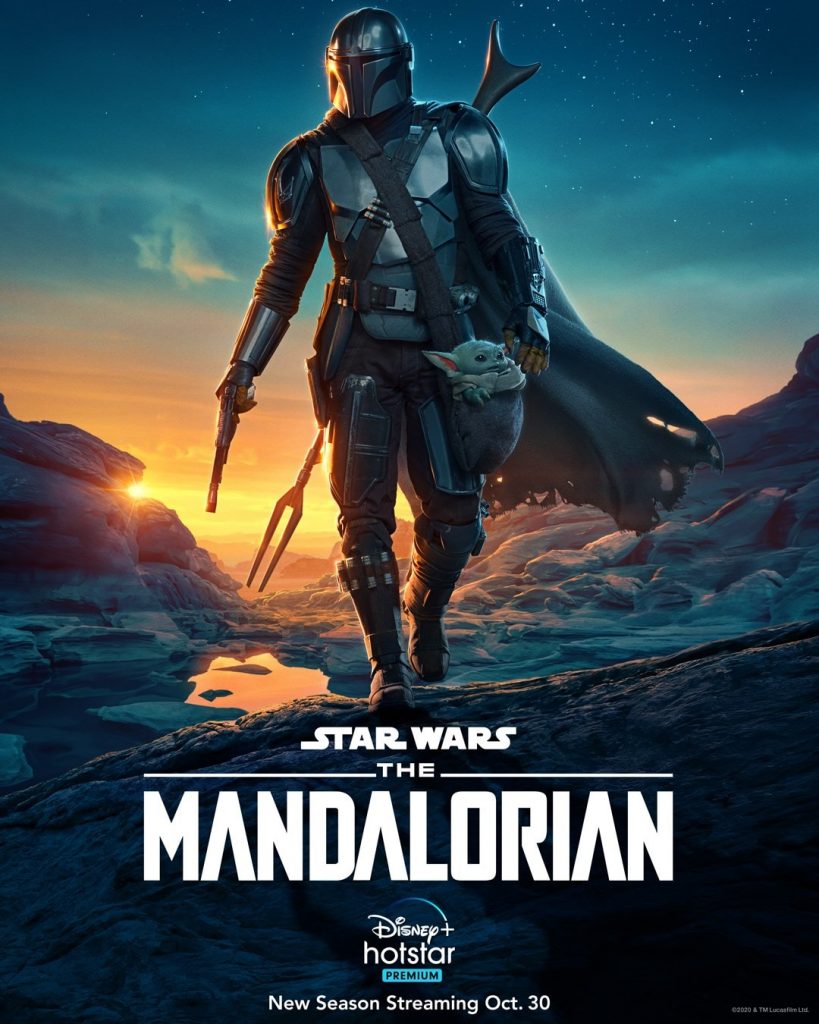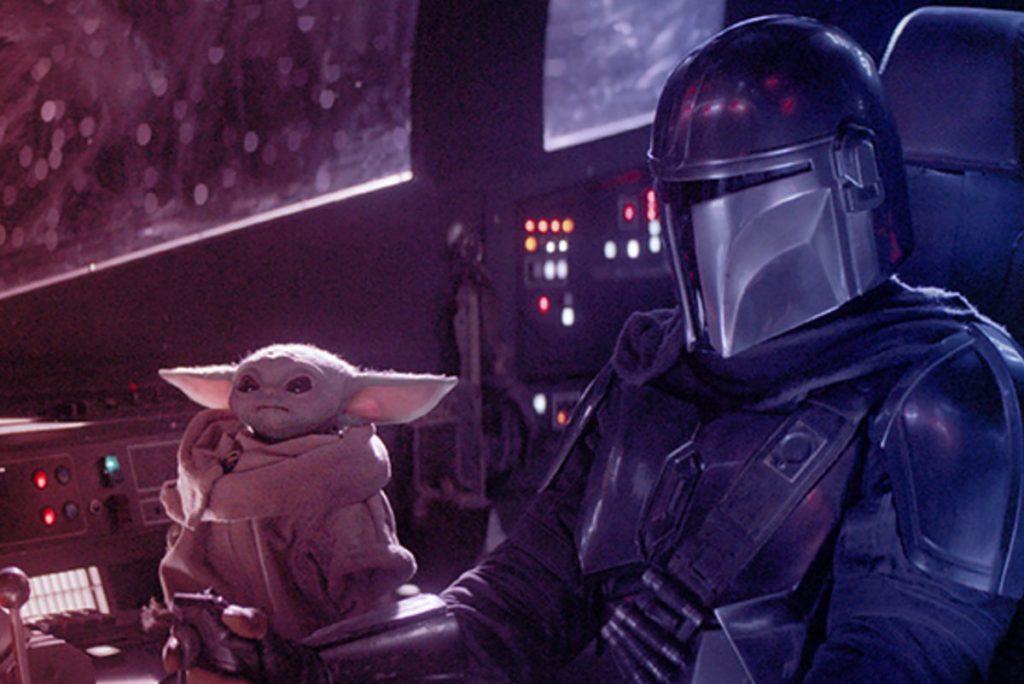Review by Tim Robins – warning… spoilers

The Mandalorian is back for a second season, bringing with it hum-drum revelations about the “The Child” – a Yoda-like, doe-eyed baby that is currently selling the Disney+ network.
Chapter 13 revealed the creature’s name – drum roll, spoiler alert, dramatic pause… it’s “Grogu”. (Cue the sound of tumbleweed blown by a desert wind).
Grogu is the show’s central McGuffin. An enigma at the outset, the creature has a price on its head, placed by nefarious members of the fallen Empire. A Mandalorian bounty hunter (played by Pedro Pascal) captures the child but then forms a bond with him because the Mandolrian was himself a “foundling”. So, heart tugging stuff.
During the Mandalorian’s quest to return Grogu back to the Jedi, he encounters various ersatz members of the Mandalorian’s own clan, pretenders to the sacred Beskar armour. These include Bobba Fett (Temuera Morrison), whose Dad was another Mandalorian foundling.
Chapter 13 sees Grogu captured by an evil Moff (are there any other kind?). Chapter 14 was Grogu free, as the Mandolorian sought to find the coordinates to the creature’s new location with the aid of his temporary allies Bobba Fett, Fennec Shand (Ming Na Wen) and Cara Dune (Gino Carano).

The Mandalorian has an excellent supporting cast, including (the voice of) Nick Nolte and Werner Herzog, with Giancario (Breaking Bad) Esposito as the coldly menacing Moff Gideon. The Mandolorian often plays off women characters, including a crusty space-port manager Peli Motto (Amy Sedaris) and a “Frog Lady” who hires the Mandalorian to reunite her spawn with their Frog-like Father. This latter scenario provides a small piece of character development for “The Child”, who goes from eating one of the eggs to playing with a hatchling tadpole.
Showrunner Jon Favreau pitched The Mandalorian as an adventure in the sleazy side of the Star Wars universe , which has always been more fun and diverse than the goings-on of the white bread Skywalker clan. One of the series’ strengths is Favreau’s deft handling of Star Wars tropes and iconography, while doing what fan folk minimally want: providing characters that deepen and extend the Star Wars universe without shattering continuity or the minds of more dedicated audiences.
As a whole, the venture has been well received. The choice of a Mandalorian as a central character was inspired because, for Star Wars aficionados, the Mandolorians come with a complex continuity. Just take a quick, less than-even-one-parsec, side trip to starwars.fandom.com and you will learn things such as, the Mandalorians were a clan-based cultural group that was composed of members from multiple species all bound by a common culture, creed, and code. They originated on the planet Mandalore in the galaxy‘s Outer Rim Territories and had a particularly important role in galactic history as legendary warriors against the Jedi. From their homeworld, Mandalorians had flourished across Mandalorian Space and the galaxy at large, colonising worlds such as Kalevala, Krownest, and Concord Dawn.
(Feel free to follow any links if you believe in re-incarnation and think you’ll have another life to waste).
But who am I kidding? Such twaddle is the very stuff of fandom, a “secret knowledge” (pace Martin Barker) earned over hours spent exchanging information on the net, conversations at conventions and reading material to determine what is or is not canon. Knowledge of continuity is also a fandom’s greatest weapon, ready to be aimed at anyone who misses the mark – exemplified by fan reaction to The Rise of Skywalker, which might as well have arrived in cinemas with a target on its back.
The Mandalorian wears its sources with a breezy confidence. The influence of Akira Kurosawa and Kurosawa inspired Spaghetti Westerns on George Lucas’ Star Wars universe is well documented. But critics’ knowing winks to viewers that Star Wars was always a “Western in Space” are off base. The creator of the Star Wars reference points were much wider, and even included science fiction (gasp) – notably Flash Gordon serials and Dune.
Of course, during Season One, The Mandalorian Chapter Four was based on the plot of The Magnificent Seven and Chapter Five has been compared with The Gunslinger, but the series isn’t simply “The Man With No Name”, with a spaceship instead of a horse.
Chapter 14, for example, offers a good example of the show’s multi-faceted references. The Mandolorian and company hijack a Rhydonium transporter and are pursued by “pirates” as they try to drive it back to base. If the show were merely a TV Western, then the transporter would be read as a stagecoach, the “pirates” as “Indians” – and I’d be shaking my head at the casual racism of Lucas’ Star Wars universe. But, for me, the sequence also recalled Georges Arnaud’s The Wages of Fear (filmed as Hell Drivers and Sorcerer), about truck drivers carrying a dangerous cargo of nitroglycerin over a mountainous terrain. This may all be “on the nose” – but the over familiar plots allow the show to tell its stories briskly and spend time on other things, particularly world building.
Visually, the show can be stunning. The use of stages composed of digital pixels has replaced green screen with an efficient way of creating alien landscapes that can be seen by the performers and tracks camera moves and light sources.
The aliens are good fun, too. This season has seen a gigantic Phallus dentata – a sand surfing Krayt Dragon (Chapter 9), and a nest of horrid snow spiders (Chapter 10). In terms of effects, “The Child” doesn’t really transcend its muppety, glove puppet origins as a kind of supernatural Sooty, particularly in Chapter 13, which is a three hander between the child, The Mandalorianand Ashoka (Rosario Dawson), Anakin’s apprentice plucked from the animated Star Wars: The Clone Wars.

The Mandolorian himself proved an easy target for critics. The character, a Ronin of sorts, embodies a certain masculine type exemplified by Worf in Star Trek: The Next Generation, and Drogo in Game of Thrones. Such characters are always in the grip of some code of honour, whose rigid values must never be breached but are also continually under threat from the world outside their inner monologue. This leaves such characters often barely able to speak and simmering to the point of boiling over in violent action, should the offence become too great.
The Mandalorian supplements his emotional armour with his actual, sacred body armour – the best in the galaxy – including a helmet that must never be removed. Some of this stuff would be laugh-out-loud funny were it not for the suspicion that such fantasised identities are lived out in the minds of actual men and has given the term “toxic masculinity” popular and troubling currency beyond Cosplay. But the character is a little more nuanced than jokes about him onanistically polishing his helmet might suggest. And in Chapter 14, he actually takes off his armour and we see his face (sacre bleu!).
The show has been more generously interpreted as exploring the trials and tribulations of bringing up a baby. But this also rests on the stereotype of incompetent fathers and really hasn’t progressed much beyond Worf’s relationship with his son, Alexander.
I have been told that The Mandalorian is an example of Dadification, a term used mostly in relation to video games.This refers to game designers and writers growing up, becoming parents and expressing their feelings of protectiveness and caring through their chosen medium. Well, maybe. I’m more interested in the way patterns of media consumption have changed over decades. In my parent’s day, adulthood normally spelt the end of record buying; being a grown up meant struggling to buy furniture or rent a TV. Now we seem part of an infantilisation of adulthood, where even in retirement, my friends are surrounded by glass cabinets filled with Eaglemoss characters, bookshelves packed with expensive reprints of 1960’s comics – or retreating to the garden shed to dust off a life-size replica Dalek.
It is no surprise that “Baby Yoda” is set to be the must-have toy this Christmas. And there are versions for all ages and pay-packets. The character comes in a variety of sizes and materials, including key ring fobs, a gigantic ‘Pop’ Vinyl figure and a £30 quid ‘plush version’ that is ideal for parents suffering “empty nest” syndrome this Christmas or acting as a stand-in for “Baby Jesus” in family Nativity scenes. And a fully animatronic version can be yours for a mere sixty Calamari.
Beyond that, The Mandalorian shouldn’t trouble anyone over the age of eight. I’ll keep tuning in, because everyone needs a relaxing watch these days when our lives seem more threatening than anything the Empire has to offer. And the individual chapters are wonderfully forgettable. I rewatched Season Two for this review and found I had already forgotten the specific content of Chapters. And you will too.
The upside to this is that I got to enjoy them all over again. And so will you.
Tim Robins
• The Mandalorian airs on Disney+. A UK subscription is £5.99
Readers are reminded a review is an opinion. Other opinions are available
A freelance journalist and Doctor Who fanzine editor since 1978, Tim Robins has written on comics, films, books and TV programmes for a wide range of publications including Starburst, Interzone, Primetime and TV Guide.
His brief flirtation with comics includes ghost inking a 2000AD strip and co-writing a Doctor Who strip with Mike Collins. Since 1990 he worked at the University of Glamorgan where he was a Senior Lecturer in Cultural and Media Studies and the social sciences. Academically, he has published on the animation industry in Wales and approaches to social memory. He claims to be a card carrying member of the Politically Correct, a secret cadre bent on ruling the entire world and all human thought.
Categories: Digital Media, downthetubes News, Features, Merchandise, Other Worlds, Reviews, Star Wars, Television
The revealing of Mando’s face in Chapter 14 was shocking and a huge mistake. The whole enigma of The Mandalorian was ruined by taking off his helmet to reveal a real dork, compared to the butch, square-jawed and chiseled featured face I had imagined.